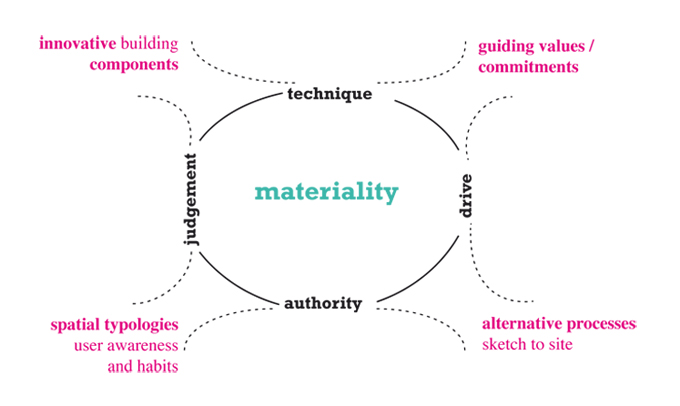Craftsmanship in the Digital Age: Architecture, Values and Digital Fabrication
with the Netherlands Embassy in Berlin, NOWlab and Forschungsinitiative Zukunft Bau (BBSR)
2017
A series of Lab Talks and Round Table expert workshops on the potential of digital technologies to trigger innovative responses to the design and making of architecture

INTRODUCTION AND AIMS
Craftsmanship in the Digital Age invited established manufacturers, proponents of newer digital production tools, architects, and building industry representatives, to co-articulate a craftsmanship approach to incorporating digital fabrication into architecture.
Rather than seeing digital tools as incongruous with craftsmanship, Craftsmanship in the Digital Age proposes that they could in fact strengthen certain skills and principles characteristic of craftsmanship with benefits for architecture and manufacturing, including; more effective building materials and spatial typologies, a closer working relationship between architects and manufacturers, and an assertion of critical values for the building industry at this point in history, especially regarding energy and resource sustainability.
We are at a point in history when mankind’s drain on the earth’s resources is finally acknowledged, but barely controllable. As Richard Sennett summarised (2008:12. Sennett R. The Craftsman. Yale University Press): "In both natural resources and climate change, we are facing a physical crisis largely of our own human making...To deal with this physical crises we are obliged to change both the things we make and how we use them. We will need to learn different ways of making buildings and transport and to contrive rituals that accustom us to saving. We will need to become good craftsmen of the environment." Concurrently, a new age of digital production has dawned, promising expanded product functionality and alternative design-to-making processes with new, environmentally friendly materials. Yet, it has made little impact on the seemingly unstoppable march of mass production and mass importation of products.
Delivered as series of five Lab Talks and workshops, Craftsmanship in the Digital Age showcased from the present-day studio, factory, laboratory and building site, while simultaneously exploring a future blurring of these work spaces and their products.
EVENTS
#1 Architecture, Materiality and Technology
Lab Talk: 3 February 2017, Expert Roundtable: 4 February 2017. Video Recording
Tracing over time the relationship between design and making, and the evolution of the architecture process, up to the present day moment when the scope of materials can be considered in combination with the potential of digital technology.
#2 Innovative Building Components
Lab Talk: 21 April 2017, Expert Roundtable: 22 April 2017. Video recording
Exploring the merits and challenges of the spectrum of additional functionality digital fabrication can add to building components, beyond the aesthetic and structural; e.g. biodegradability, embedded energy, data-driven responsiveness
#3 Resetting Values for Architecture and the Building Industry
Lab Talk: 15 September 2017. Video Recording
Identifying the societal responsibilities which digital fabrication could assist the building industry in addressing: e.g. commitment to efficient use of depleting natural resources, and public finances; halting the seemingly unstoppable march of mass production and mass importation of products; protection of knowledge and welfare of manufacturing work force to keep pace with technological automation.
#4 Alternative Sketch to Site Processes
Lab Talk: 10 November 2017, Expert Roundtable: Saturday, 11 November 2017. Video Recording
The digital era is enabling the emergence of new structures for managing the communication chain in the building process, e.g. BIM. Which frameworks include the manufacturers of building components and allow for closer communication with the architect - between the sketch and the finished component?
#5 Craft in Code – a lecture by Richard Sennett
Concluding Roundtable and Lecture: 18 December 2017. Video Recording
With reflections from Richard Sennett, author of The Craftsman and his provocation that "we are obliged to change both the things we make and how we use them...to become good craftsmen of the environment"; and with focused discussions on three core themes of the emerging 'digital building culture', the alternative building process and practice it demands, and the prospects offered for socio-politically and environmentally responsible architecture.
A CRAFTSMANSHIP APPROACH TO INTEGRATING DIGITAL FABRICATION INTO ARCHITECTURE

The core premise of this proposed approach is that digital fabrication can reinstate materiality at the centre of architectural design thinking. At the computer-aided-design end of the design-tools spectrum, it enables information about how a spatial form will be constructed to be fed into computational design tools, thus counter-balancing an emphasis on formal expression. At the opposite end of the spectrum, digital fabrication can support the return of techniques (e.g. casting) and aesthetic articulation (e.g. ornamentation) that are usually too expensive.
Materiality is central to craftsmanship. Described simply, it is the bridge between the hand and the head which both demands and hones skills of craftsmanship; namely technique, judgement, authority and commitment/drive. What sets architecture apart from most other design fields is the complex, indirect and drawn-out journey between the idea in the studio and its realisation on site. Despite the head-to-hand relationship being mediated by algorithms and by the limitations of the fabrication machine, working with digital tools and techniques theoretically offers potential to shorten and simplify the studio to site process, and perhaps to think of site in term of workshop. This materiality depends too on masterful technique, judgement, authority and commitment/drive.
Learning these skills, like with any skill, is influenced by the defining particularities of the practice realm - guiding positions and emphases, ways of working, and product range/type. Certain such cornerstones are required to anchor digital fabrication in architecture practice, and the effort and practice of putting these in place will simultaneously develop and reinforce the aforementioned core craftsmanship skills:
- New/ alternative design to construction processes, with ‘data’ underpinning the communication chain. This supports commitment/ drive towards sustainability and curatorial authority
- Commitment to efficient use of material. This encourages drive towards sustainability in construction, and advances technique by exploring formal expressions/prototypes for efficient structural dynamics.
- Development of innovative/inventive building components/products, with expanded functionality beyond the aesthetic and structural. Dependent on technique and experienced judgement.
- Design of spatial typologies and elements that cue change of use habits and ways of living. Requires and further refines the authority/expertise and judgement of the architect.
Perhaps the expertise described here fits less to the architect we know today, than to a new type of craftsperson for buildings and spaces, committed to the collective societal goal of the sustainable use of the earth’s resources.
An ANCB Collaborative Project with the Netherlands Embassy in Berlin, NOWlab, Berlin and Forschungsinitiative Zukunft Bau (BBSR), BonnANCB PROGRAMME
Theme
#responsivecity
Enquiry Programme
#craftsmanship
More
Concept Paper
Contact
Áine Ryan,
ar@aedes-network-campus.de
ANCB Partners

